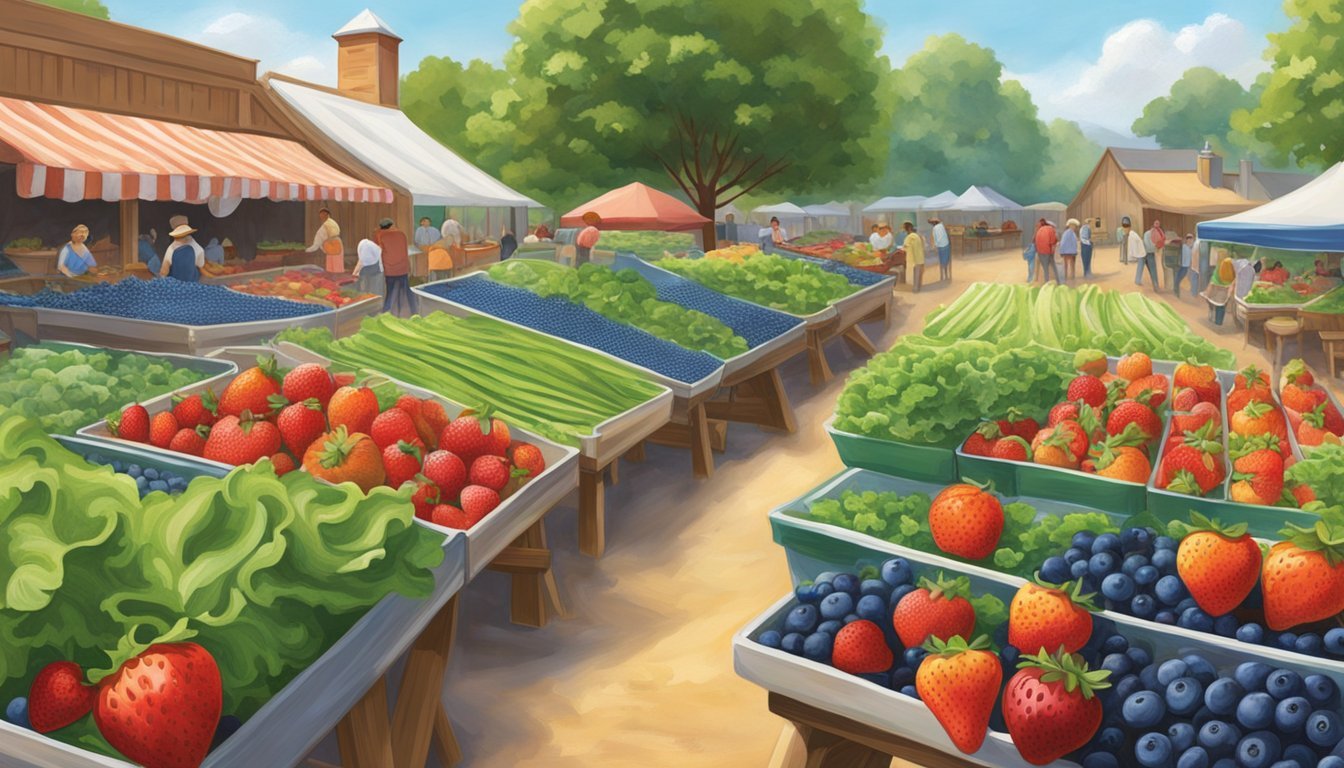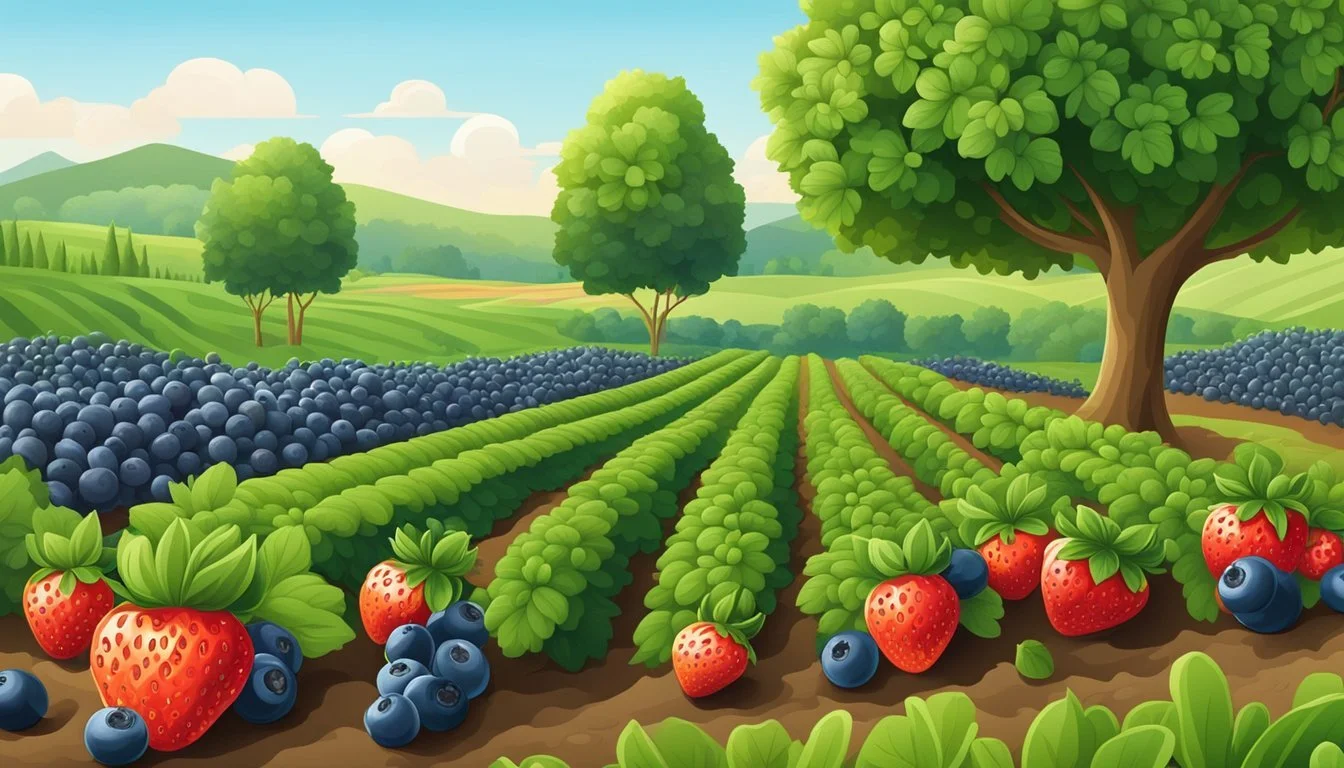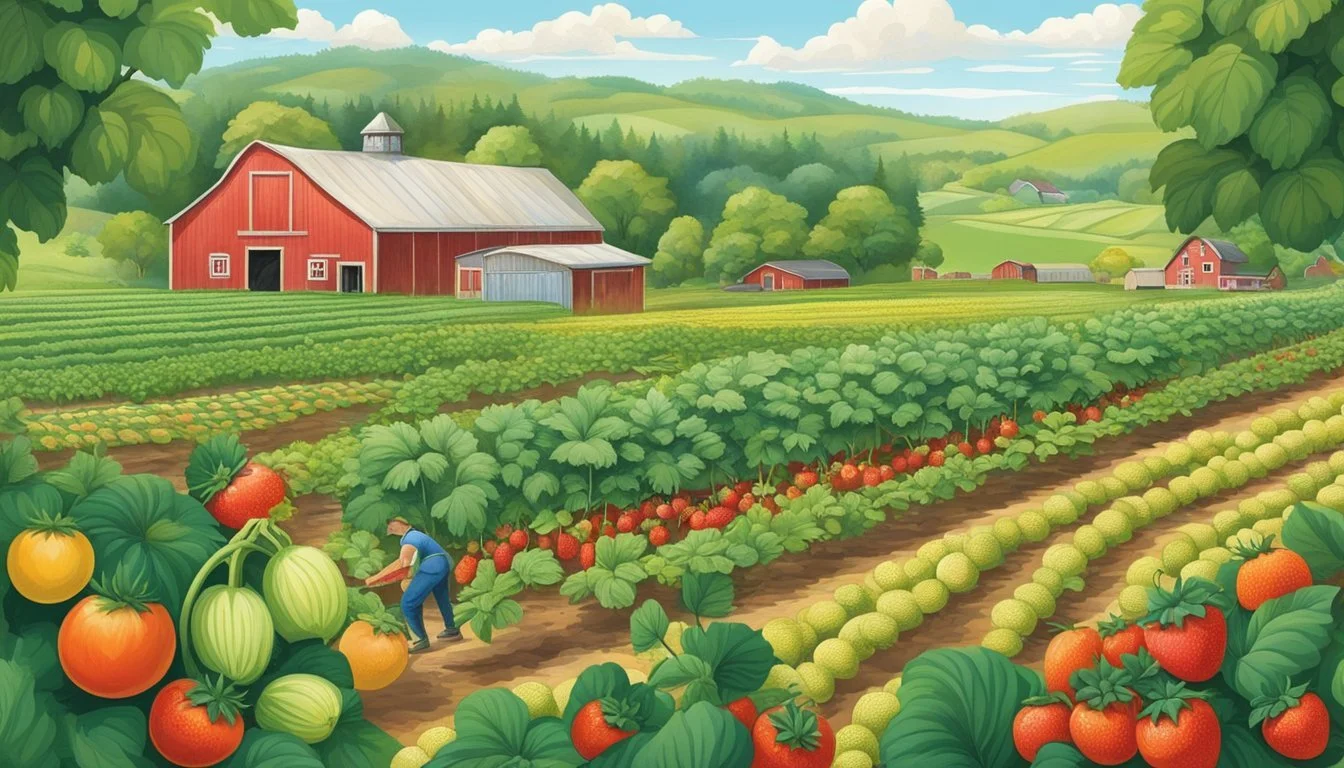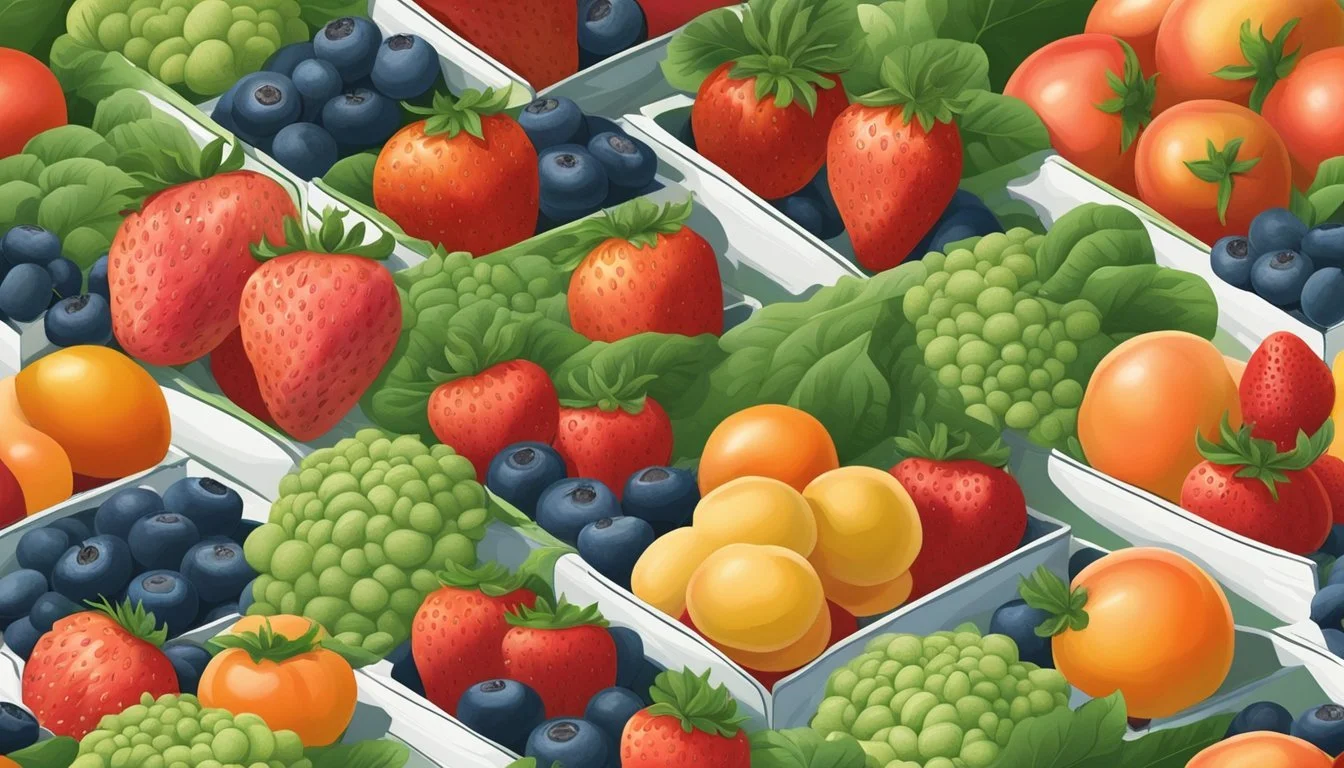Connecticut Seasonal Fruit & Vegetables in June
Your Fresh Guide
This Article is Part of our Connecticut Seasonal Fruit & Veg Calendar
June in Connecticut marks a vibrant period in the agricultural calendar as an array of fruits (What wine goes well with fruit?) and vegetables reach their peak ripeness, offering fresh and flavorful produce to local consumers. Embracing the season's bounty not only supports Connecticut’s farmers and contributes to the local economy, but also ensures that the produce on the table is at its most nutritious and delicious.
During this month, shoppers can expect to find farm stands and markets bustling with activity as they display a variety of locally grown options. Among the fruits, strawberries are a standout, bursting with sweetness, perfect for enjoying fresh or in desserts. In the vegetable aisles, carrots, and a kaleidoscope of leafy greens like chard dominate, alongside the arrival of tender ears of corn (how long does corn last?).
Connecticut's climate and soil yield an impressive assortment of produce that continues to evolve through the season. June’s offerings are particularly notable for their freshness and taste, providing a compelling reason for residents and chefs alike to seek out these seasonal ingredients for their next culinary creation.
Seasonal Overview of Connecticut
As Connecticut transitions from spring to summer in June, the state enjoys an abundance of diverse produce. The harvest times begin to peak, offering fresh, seasonal fruits and vegetables that are at their best in terms of flavor and nutritional value.
Spring to Summer Transition
The shift from spring to summer in Connecticut is marked by warmer temperatures and lengthening days, which contribute to the growth and ripening of a variety of produce. The state's farmers markets begin to brim with vibrant colors as the last of the spring produce makes room for the beginning of the summer bounty. This period is significant for growers and consumers alike, who anticipate the fresh flavors that accompany the seasonal transition.
June's Harvest Calendar
Connecticut's June harvest calendar showcases a range of fruits and vegetables. Here is a concise list of what shoppers can expect to find in their local markets during this month:
Fruits:
Strawberries
Cherries (how long do cherries last?)
Blueberries (late June)
Vegetables:
Lettuce
Spinach
Radishes
Peas
Beets
Broccoli
Cabbage
The availability of each fruit and vegetable depends on that year's specific weather conditions, which may slightly adjust harvest times. However, these items are typically ready to be enjoyed in June, giving consumers access to fresh and nutritious options.
Fruit Availability in Connecticut
June marks a vibrant period in Connecticut, as several types of fruits come into season, offering freshness and variety to the local markets.
Berries in Bloom
June is a prime month for berry picking in Connecticut, with strawberries taking center stage. They are typically at their peak, offering sweet and plump choices. This is also the time when blueberries begin to ripen, hinting at the full bounty that will be available as the summer progresses.
Strawberries: In season, abundant, and fresh.
Blueberries: Starting to appear, with availability increasing towards the end of the month.
Tree-Fruit Treasures
Connecticut's tree fruits are just beginning their season in June. While cherries might be found in limited quantities, the true star is the early varieties of peaches, which promise a juicy and flavorful experience.
Cherries: Available, but may be limited.
Peaches: Early varieties start to become available, flavorful.
Vegetable Harvest in June
June in Connecticut marks the transition from spring to summer, bringing a diverse harvest of vegetables. Gardens and farms are replete with tender greens, beginning to offer early summer produce.
Greens and Early Harvest
June's mild temperatures support a bounty of leafy greens. Farmers harvest varieties of lettuce and arugula, prized for their tender leaves and vibrant flavors, alongside spinach, which thrives in the early part of the month.
Arugula: Peppery and crisp, ideal for salads
Lettuce: Includes a range of types from butterhead to romaine
Spinach: Rich in iron, best when young and tender
Root Vegetables and Alliums
This month also sees a continuation of root vegetables like radishes, adding a crunchy and spicy element to dishes. Alliums, such as onions and scallions, are also harvested, providing a foundational flavor to both cooked meals (how long do cooked meals last?)and fresh salads.
Radishes: Bright red and crisp, with a peppery bite
Onions: Bulbous and pungent, maturing for culinary use
Green Onions/Scallions: Mild and versatile, used in a variety of dishes
Nightshades and Cucurbits
As June progresses, the first nightshades such as tomatoes begin to appear, although they will be more plentiful later in the season. Cucurbits like cucumbers and summer squash make their debut, signaling the start of summer's abundance.
Tomatoes: Best when ripened on the vine for full flavor
Cucumbers: Cool and crisp, often used in salads
Peppers: Varied from sweet to hot, starting to flourish
Squash: Includes zucchini and other summer varieties, versatile for cooking
Herbs and Aromatics of the Month
In June, Connecticut gardens begin to flourish with a variety of herbs that are perfect for culinary use. These fresh additions can transform an ordinary meal into a fragrant and flavorful dish.
Aromatic Additions
Basil: This herb thrives in the warmth of June. Its bright and slightly peppery flavor is essential in dishes such as pesto, salads, and pastas.
How to use: Fresh basil leaves can be torn and sprinkled over dishes just before serving to preserve its delicate flavor.
Mint: Recognized for its cool and refreshing taste, mint is an extremely versatile herb used in sweet and savory recipes alike.
Best Pairings: Mint complements lamb dishes well and can be used to spruce up summery beverages and desserts.
Thyme: With tiny, fragrant leaves, thyme is hardy and well-suited for the growing conditions in June. It imparts a subtle, earthy flavor ideal for grilling and roasting.
Culinary Tips: Thyme's robust nature allows it to withstand longer cooking times, making it a great addition to soups and stews.
Parsley: Parsley is a staple in many gardens and kitchens. By June, it offers its bright green leaves and a clean, slightly bitter taste to enhance the flavor of a variety of dishes.
Usage: It can be used both as a garnish and a flavoring component in sauces, salads, and marinades.
Preparing for Upcoming Months
As the summer season progresses in Connecticut, various fruits and vegetables reach their peak, providing an opportunity for both farmers and consumers to prepare for the freshest produce.
Looking Ahead to July
In July, individuals can expect an increase in the availability of beans and corn. These crops benefit from the warm temperatures, which contribute to their growth and flavor development.
Beans: Look for them starting in July, as they enter their prime season.
Corn: Typically starts to appear in the markets in July, signifying the start of its peak season.
Anticipating August
August brings with it a bounty of eggplant (What wine goes well with eggplant?) and zucchini, signifying their peak season in Connecticut. These vegetables are versatile in the kitchen and can be found in abundance during the month.
Eggplant: It generally reaches its peak in August, offering its rich, versatile flavor for both grilling and baking.
Zucchini: Also hitting its stride in August, this vegetable is known for its prolific yields and is a favorite in summer dishes.
Connecticut's Local Farming Practices
Local farms in Connecticut have embraced various methods to ensure sustainability and community engagement. They focus on ecological balance and building relationships with consumers through direct sales.
Sustainable Agriculture
Sustainable agriculture is at the heart of Connecticut's farming philosophy. The state's farmers employ practices like crop rotation, organic farming, and the use of green manure to promote soil health and reduce chemical use. Integrated Pest Management (IPM) is a common strategy to control pests with minimal impact on the environment. Local farms often use cover crops to maintain soil fertility and prevent erosion.
Community Supported Agriculture (CSA)
Community Supported Agriculture (CSA) programs are prevalent throughout Connecticut, creating a direct partnership between local farms and the community.
Key Components of CSAs in Connecticut:
Seasonal subscriptions from consumers
Weekly or bi-weekly shares of produce
Opportunities for consumers to visit the farms
By joining a CSA, community members receive fresh, local produce, typically harvested at its seasonal peak in June, and contribute to the stability and financial support of local farms. CSAs also often offer educational experiences for members, fostering a deeper understanding of agriculture.
Health Benefits and Cooking Tips
June's fresh produce in Connecticut offers a variety of health benefits and culinary opportunities. Locally sourced vegetables and fruits not only provide rich nutrition but also inspire a multitude of cooking techniques to enhance any meal.
Nutritional Highlights
Seasonal fruits and vegetables harvested in June are abundant in vitamins, minerals, and antioxidants. Strawberries and blueberries, for instance, are high in vitamin C and dietary fiber. They support immune function and digestive health. Avocado, a creamy fruit enjoyed in various dishes, is a good source of healthy fats and potassium, vital for heart health. Arugula and cucumber, common in salads, are low in calories yet high in hydration and essential nutrients like vitamin K.
Peaches, another June favorite, provide vitamin A and are known for their skin health benefits. Corn, a staple at many barbecues, has B vitamins, magnesium, phosphorus, and dietary fiber, making it beneficial for energy metabolism and digestive health.
Culinary Inspiration
Seasonal produce offers a spectrum of flavors and textures that can inspire numerous recipes.
Strawberries and blueberries:
Ideal for: smoothies, salads, desserts
Tip: Use them as a natural sweetener in yogurts or oatmeal.
Avocado:
Ideal for: guacamole, toast toppings, salad dressings
Tip: Mash it for a creamy sandwich spread or dice it for a fresh taco filler.
Arugula:
Ideal for: pizzas, pasta dishes, peppery salads
Tip: Add to dishes last moment to retain the leafy green's bite and nutrients.
Cucumber:
Ideal for: sandwiches, drinks, cold soups
Tip: Slice thinly for a refreshing twist in water or cocktails.
Peaches:
Ideal for: grilling, pies, jams
Tip: Grill peaches to caramelize their natural sugars, enhancing their sweet flavor.
Corn:
Ideal for: roasting, grilling, salads
Tip: Add roasted corn (how long does roasted corn last?) kernels to salsas for a sweet and smokey taste.
Integrating these ingredients into daily cooking not only adds nutritional value but also keeps meals vibrant and enjoyable.
Where to Find Seasonal Produce
In Connecticut during the month of June, one can find a vast array of fresh produce ripe for the picking. Availability peaks at local farmers markets and grocery stores, offering a way to support the regional economy and enjoy just-harvested flavors.
Farmers Markets
Farmers markets are the ideal venues for sourcing the freshest seasonal fruits and vegetables. June’s offerings at Connecticut farmers markets typically include strawberries, leafy greens, and herbs. These markets not only showcase a diversity of products but also allow direct interaction with growers. Below is a list of some common fresh produce available at Connecticut farmers markets in June:
Fruits: Strawberries, Blueberries
Vegetables: Lettuce, Spinach, Radishes
Herbs: Basil, Mint, Cilantro
To ensure getting the best selection, shoppers are encouraged to arrive early as popular items tend to sell out quickly.
Local Grocery Stores
Local grocery stores in Connecticut also stock seasonal produce, often highlighting local and regional farms. While the selection may not be as extensive as at farmers markets, stores provide a convenient alternative with consistent hours and locations. Freshness and availability can depend on the store’s supply chain, but efforts are usually made to source locally. Here's what one can typically find:
Fruits: Cherries, Strawberries
Vegetables: Kale, Zucchini, Summer Squash
Herbs: Dill, Parsley
It's worth noting that purchasing local produce at these stores often benefits the local agricultural community and reduces the environmental impact associated with long-distance transportation.
Conclusion
June is a vibrant month for agricultural produce in Connecticut. Freshness and flavor peak during this time for many fruits and vegetables. Consumers have the opportunity to enjoy a variety of options from local farms and markets.
Seasonal Vegetables:
Lettuce
Spinach
Radishes
Peas
Seasonal Fruits:
Strawberries
Cherries
The availability of fresh produce ensures that meals can be both nutritious and delicious. Vegetables such as lettuce and spinach offer crisp textures and are ideal for salads. Radishes add a peppery punch to dishes, while peas can be savored fresh or cooked.
In the fruit category, strawberries and cherries are coveted for their sweet juiciness. These fruits are often at their peak, providing a wonderful complement to desserts, breakfasts, or as stand-alone snacks.
As June unfolds in Connecticut, residents and chefs alike can take full advantage of the season's bounty. Eating locally and seasonally not only supports Connecticut farmers but also contributes to a more sustainable food system. The state's agricultural outputs during this month are emblematic of the rich farming heritage and the commitment to quality and freshness found within the region.









